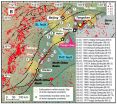To assess future seismic hazards along the fault, scientists from the University of California at Los Angeles (UCLA) and the Chinese Earthquake Administration (CEA) have reconstructed, for the first time, a spatial pattern of major earthquakes along the fault. Their reconstruction is based on (1) detailed analysis of the available instrumental records in the past few decades; (2) historical records in the past ~4,000 years; and (3) pre-historical records tracing back nearly 11,000 years.
A surprising finding from this work is the existence of a 160-km seismic gap centered at Tianjin, which has not been ruptured by any major earthquake for more than 8,400 years. As the average earthquake cycle is about 8,700 years, the authors suggest that the 160-km Tianjin fault segment, capable of generating a devastating earthquake similar to the 1976 Tangshan earthquake, may be the next to rupture.
FEATURED ARTICLE
A possible seismic gap and high earthquake hazard in the North China Basin
An Yin et al., Structural Geology Group, China University of Geosciences (Beijing), Beijing 100083, China and Dept. of Earth, Planetary, and Space Sciences, University of California-Los Angeles, Los Angeles, California 90095-1567, USA. Published online ahead of print on 14 Nov. 2014; http://dx.doi.org/10.1130/G35986.1.
Other recently posted Geology articles are highlighted below.
Geology articles published online ahead of print can be accessed online at http://geology.gsapubs.org/content/early/recent. All abstracts are open-access at http://geology.gsapubs.org/; representatives of the media may obtain complimentary articles by contacting Kea Giles at the address above.
Please discuss articles of interest with the authors before publishing stories on their work, and please make reference to Geology in articles published. Contact Kea Giles for additional information or assistance.
Non-media requests for articles may be directed to GSA Sales and Service, gsaservice@geosociety.org.
Coral macrobioerosion is accelerated by ocean acidification and nutrients
Thomas M. DeCarlo et al., Massachusetts Institute of Technology-Woods Hole Oceanographic Institution Joint Program in Oceanography/Applied Ocean Physics and Engineering, and Dept. of Geology and Geophysics, Woods Hole Oceanographic Institution, Woods Hole, Massachusetts 02543, USA; Corresponding author: Anne L. Cohen, Woods Hole Oceanographic Institution, 266 Woods Hole Road, Woods Hole, Massachusetts 02543, USA. Published online ahead of print on 14 Nov. 2014; http://dx.doi.org/10.1130/G36147.1.
Coral reef ecosystems provide critical shoreline protection, sustain fisheries that feed hundreds of millions of people, and harbor one quarter of all marine species. Calcium carbonate is a key ingredient for these ecosystems, and is supplied primarily by organisms including corals that construct massive skeletons and coralline algae that cement skeletons and rubble to build the reef structure. At the same time, bioeroding organisms, including mollusks, worms, sponges, and fish, break down these skeletons and dissolve the reef framework. This delicate balance between calcium carbonate production and removal is threatened by ocean acidification (OA), the decline in seawater pH driven by rising CO2 levels in the atmosphere. To test the sensitivity of bioerosion to OA, and to the combination of OA and nutrients, we exploited unique natural gradients in acidification and nutrients on eleven coral reefs spanning the tropical Pacific Ocean from Panama to the Palauan Archipelago in the western Pacific. Using 3-D CAT scans of coral skeletons collected from these reefs, we show that OA alone drives an increase in bioerosion of coral skeleton, but the sensitivity of bioerosion to OA increases ten-fold if combined with high levels of nutrients. Ocean acidification is a global threat that will increase steadily throughout the 21st century. Yet, just how much the calcium carbonate balance on coral reefs shifts in favor of bioerosion may depend, in large part, on local management strategies that limit sources of nutrients to the coastal ocean.
Coseismic landslides reveal near-surface rock strength in a high-relief, tectonically active setting
Sean F. Gallen et al., Dept. of Earth and Environmental Sciences, University of Michigan, Ann Arbor, Michigan 48109, USA. Published online ahead of print on 14 Nov. 2014; http://dx.doi.org/10.1130/G36080.1.
The strength of rock at or near Earth's surface is a key factor arbitrating the interactions between the tectonic and climatic processes that shape natural landscapes. The role of tectonics and climate in the development of topography has been intensity studied for several decades. However, because it remains challenging to determine rock strength at relevant spatial scales, few studies have quantitatively explored the influence of rock strength on landscape evolution. Sean Gallen and colleagues present a new method to calculate rock strength by using large earthquakes that deliver a strong "punch" to the landscape and generate thousands of landslides. Using the relationship between earthquake ground shaking and landsliding, they determine the strength of rocks within several of meters of the ground surface for a region along the eastern edge of the Tibetan Plateau. They find that the rocks in this setting are far weaker than typical laboratory measurements and that the pattern of rock strength is better explained by proximity to the front of the mountain range, where the number of active faults and precipitation are the greatest, rather than rock-type. This study helps further understanding of landscape development and landslide hazard assessment.
Spatial and temporal evolution of hyperextended rift systems: Implication for the nature, kinematics, and timing of the Iberian-European plate boundary
J. Tugend et al., Institut de Physique du Globe de Strasbourg, CNRS-UMR 7516, EOST, Université de Strasbourg, 1 rue Blessig, 67084 Strasbourg, France; Current Address: Laboratoire de Géologie, École Normale Supérieure, CNRS-UMR 8538, 24 rue Lhomond, 75005 Paris, France. Published online ahead of print on 14 Nov. 2014; http://dx.doi.org/10.1130/G36072.1.
What are the processes leading to the formation of divergent or transform plate boundaries? At present, little is known about how deformation may migrate and eventually localize to create a new stable plate boundary. Based on the spatial and temporal evolution of rift systems preserved at the transition between Iberia and Europe, we revisit the nature, kinematics and timing of the Iberian-European plate boundary. Observations suggest a strongly polyphased deformation history and an important partitioning of the deformation at the scale of the plate boundary throughout its evolution. The formation and reactivation of the Iberian-European plate boundary is interpreted as the result of a diffuse transient plate boundary that failed to localize. The results of this work may provide new insights on the formation of nascent divergent plate boundaries and on the kinematics of the southern North Atlantic and Alpine domain in Western Europe.
Southern Laurentide ice-sheet retreat synchronous with rising boreal summer insolation
David J. Ullman et al., College of Earth, Ocean, and Atmospheric Sciences, Oregon State University, Corvallis, Oregon 97331, USA, and Dept. of Geoscience, University of Wisconsin-Madison, Madison, Wisconsin 53706, USA. Published online ahead of print on 14 Nov. 2014; http://dx.doi.org/10.1130/G36179.1.
Throughout the Quaternary period, glacial-interglacial cycles have been the dominant source of global climate variability associated with changes in Earth's orbit and resulting incoming insolation. Powerful feedbacks within the Earth system further amplify these changes in solar forcing to drive the growth and decay of Northern Hemisphere ice sheets. However, inconsistencies among chronologies of ice margin position have allowed for numerous hypotheses on the primary trigger for initial deglaciation. Using 10Be surface exposure ages, we directly date the onset of Laurentide Ice Sheet retreat from terminal moraines and other locations in Wisconsin, USA. This new chronology, combined with an updated compilation of existing retreat data, suggests an initial retreat of ice approx. 23,000 years ago (23 ka) that was uniform across the entire southern margin from Wisconsin to New England. Because the only forcing mechanism to increase by ca. 23 ka was boreal summer insolation, we test the impact this forcing on ice sheet mass balance using a surface energy balance model of the southern Laurentide between 24 and 19 ka. These simulations show that the small initial increase in boreal summer insolation between 24 and 19 ka could indeed be sufficient to drive an increase in surface ablation along the southern margins, as hypothesized by Milutin Milanković.
Rifting and subsidence following lithospheric removal in continental back arcs
Oğuz H. Göğüş, Istanbul Teknik Üniversitesi, Avrasya Yer Bilimleri Enstitüsü, Ayazağa 34469, Istanbul, Turkey. Published online ahead of print on 14 Nov. 2014; http://dx.doi.org/10.1130/G36305.1.
It has been recognized that back-arc basin (a sedimentary basin behind volcanic arc) opens when retreating ocean plate subducts under the continental plate. However, the amount of extension and subsidence in these basins varies from hundreds of meters to kilometers depending on their pre-extensional geological condition. Recent studies suggest that geodynamic evolution of continental back-arcs in the retreating subduction systems is associated with previous lithospheric foundering events (e.g., delamination and/or dripping) where thick and heavy mantle lithosphere sinks into the mantle. This work quantitatively explores for the first time the surface response of post-convergence thinning in the back-arcs and explains how this process differs from "classical" back-arc opening. The numerical model predictions suggest that hot mantle uprising (after lithospheric removal) induce weakening of the crust therefore, high degree of extension/rifting and surface subsidence (greater than 1.5 km) in the center of the back-arc basin. The research will provide insight into the development of continental back-arc basins in the Mediterranean region (e.g., Aegean sea-West Anatolia, Alboran domain, Pannonian basin) and its relation to the subduction retreat process.
INFORMATION:
http://www.geosociety.org




